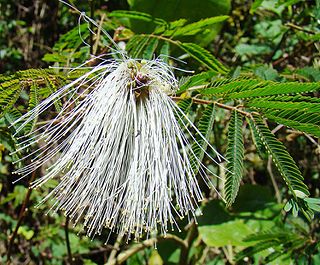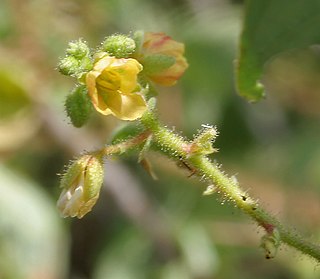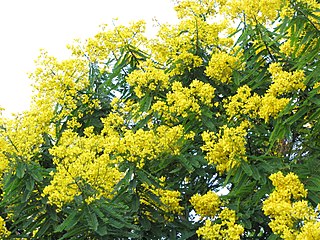
The Mimosoideae are a traditional subfamily of trees, herbs, lianas, and shrubs in the pea family (Fabaceae) that mostly grow in tropical and subtropical climates. They are typically characterized by having radially symmetric flowers, with petals that are twice divided (valvate) in bud and with numerous showy, prominent stamens.

Cercis is a genus of about 10 species in the subfamily Cercidoideae of the pea family Fabaceae, native to warm temperate regions. It contains small deciduous trees or large shrubs commonly known as redbuds. They are characterised by simple, rounded to heart-shaped leaves and pinkish-red flowers borne in the early spring on bare leafless shoots, on both branches and trunk ("cauliflory"). Cercis is derived from the Greek word κερκις (kerkis) meaning "weaver's shuttle", which was applied by Theophrastus to C. siliquastrum.

Cassia is a genus of flowering plants in the legume family, Fabaceae, and the subfamily Caesalpinioideae. Species are known commonly as cassias. Cassia is also the English common name of some species in the genus Cinnamomum of the family Lauraceae. Species of the genera Senna and Chamaecrista were previously included in Cassia. Cassia now generally includes the largest species of the legume subtribe Cassiinae, usually mid-sized trees.

Senna spectabilis is a plant species of the legume family (Fabaceae) in the subfamily Caesalpinioideae native to South and Central America. They are often grown as an ornamental in front yards, parks, gardens, buildings etc. due to their bright yellow flowers that bloom during the summer months. They are also known as golden wonder tree, American cassia, popcorn tree, Cassia excelsa, golden shower tree or Archibald's cassia.

Senna, the sennas, is a large genus of flowering plants in the legume family. This diverse genus is native throughout the tropics, with a small number of species in temperate regions. The number of species is estimated to be from about 260 to 350. The type species for the genus is Senna alexandrina. About 50 species of Senna are known in cultivation.

Senna alexandrina is an ornamental plant in the genus Senna. It is used in herbalism. It grows natively in upper Egypt, especially in the Nubian region, and near Khartoum (Sudan), where it is cultivated commercially. It is also grown elsewhere, notably in India and Somalia.
Rupert Charles Barneby was a British-born self-taught botanist whose primary specialty was the Fabaceae (Leguminosae), the pea family, but he also worked on Menispermaceae and numerous other groups. He was employed by the New York Botanical Garden from the 1950s until shortly before his death.

Abarema adenophora is a species of plant in the family Fabaceae. It is native to Northern South America, Costa Rica, and Nicaragua.

Senna macranthera is a tree in the family of Fabaceae.

Senna sophera is a shrub or tree in the bean family Fabaceae. It is now widespread in tropical and subtropical regions of the world, but is believed to be native to tropical America. Originally described by Carl Linnaeus in 1753 as Cassia sophera, it has acquired a large number of synonyms. Vernacular names include algarrobilla, baner, kasunda, kasaundi (Hindi) and kolkasunda (Bengali).
Senna obliqua is a species of flowering plants in the legume family Fabaceae, and the subfamily Caesalpinioideae. It is found in Peru.

Balizia elegans is a species of flowering plants in the family Fabaceae. It is a tree in the emergent layer of the tropical rainforest of South America.

Senna surattensis is a plant species of the legume family (Fabaceae) in the subfamily Caesalpinioideae.

Senna pendula, also known as Easter Cassia, Christmas Senna, winter Senna, climbing Cassia, golden shower, pendant Senna and valamuerto, is a plant of the Fabaceae family with a shrub habit that is native to South America. It used in various parts of the world as an ornamental plant and is an environmental weed in Australia. The flowers are yellow and the name pendula means 'pendulous' or 'drooping'.

Chamaecrista absus, the pig's senna or tropical sensitive pea, is a species of flowering plant in the family Fabaceae, with a worldwide distribution in the tropics and subtropics. An annual herb reaching 60 cm (24 in), it is a common weed of cultivated and waste places, and its seeds are regularly harvested and sold for use in traditional medicine in Africa and Asia.

Cassia ferruginea is a species of flowering plant in the family Fabaceae, native to Brazil. It is used as a street tree in a number of Brazilian cities.

Senna multijuga, the November shower or false sicklepod, is a species of flowering plant in the family Fabaceae. It is native to wet tropical areas of Latin America, and widely introduced to other tropical locales such as Africa, India, Indonesia, China, Australia, and Hawaii. A fast-growing tree typically 10 m (33 ft) tall, it is planted in restoration projects, as an ornamental, and as a street tree, being especially useful under power lines.

Senna lindheimeriana, the velvet leaf senna, is a species of flowering plant in the family Fabaceae. It is native to the US states of Arizona, New Mexico, and Texas, and to eastern Mexico. A perennial typically 1.5 m (5 ft) tall, it is hardy to USDA zones 8a, and is recommended for xeriscaping and for feeding birds, butterflies and bumblebees. It is thought to be lethally toxic to livestock, but is so foul-smelling and unpalatable that only starving mammals will consume it.

Senna roemeriana, the twoleaf senna, is a species of flowering plant in the family Fabaceae, native to the US states of New Mexico and Texas, and to northern Mexico. A perennial of limestone soils and typically 18 in (46 cm) tall, it is toxic to livestock, particularly goats and sheep, but they avoid consuming it with proper range management.
Senna bauhinioides, the twinleaf senna, is a species of flowering plant in the family Fabaceae. It is native to the US states of Arizona, New Mexico, and Texas, and to northern Mexico, and it has been introduced to the US state of Maryland. An opportunistic species, it is unpalatable to livestock, so its presence is considered an indicator of overgrazing.

















